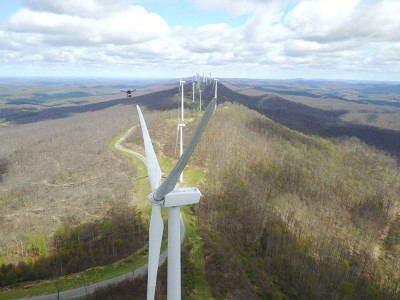Recent news has showcased what the successful adoption and scale of drone technology can look like in the energy & utilities sector with the New York Power Authority (NYPA) launching an in-house drone operation. This multi-million dollar program will enable new inspection capabilities over the next few years, fully transforming what had been a piecemeal approach to an integrated UAV structure.
That UAV structure can be defined as end-to-end drone mission management, covering every aspect of drone operations from pre-flight planning to post-flight analytics. It’s something that ANRA Technologies supports in a big way with their combined Mission, Fleet and UAS Traffic Management (UTM) services as a single solution called Mission Manager X (MMX). This total solution can utilize drone-in-a-box (DiB) hardware that allows energy and utility companies to streamline their operations, optimize workflows, and reduce manual efforts. MMX can also help with getting the necessary regulatory approvals to operate BVLOS.

Brent Klavon, Chief Strategy Officer at ANRA Technologies, detailed how these efficiencies have enabled organizations to go far beyond the kind of “spreadsheet management” process that can bottleneck drone workflows during a recent ANRA Huddle, but we wanted to learn more about how MMX can help to improve safety and mitigates potential hazards, why MMX is ideal for enterprises that want a singular solution for fleet and airspace management, and much more.
Our questions for Brent are below, but you can ask him your own questions over at the ANRA booth (#134) at the Commercial UAV Expo this September in Las Vegas.
Jeremiah Karpowicz: You’ve detailed how ANRA can help energy & utilities professionals that are responsible for their enterprise drone programs remain compliant while streamlining workflow efficiencies. What can you say about how MMX eases both the regulatory and logistical challenges that often come with the adoption of this technology?
Brent Klavon: ANRA continues to be a FAA certified Low Altitude Authorization Notification Capability (LAANC) provider, which is something we’ve done since 2020. We can display both Broadcast and Network Remote ID for drones, and increasingly more significant technology internationally as many regions are mandating this capability.
In addition to fleet management, MMX has elements of UTM that can help lower ground and air risk to acceptable levels for a winning safety case. The FAA is keen on including UTM capability in applications for BVLOS waivers and is developing a process to evaluate a UTM safety mitigation for known hazards identified in FAA Order 8040.6 Appendix A.
On the logistics side, some energy & utility organizations have rushed to purchase DiB systems only to realize they have half of the solution – essentially the DiB -- but are missing the capability to mitigate risk to an acceptable level to enable operations without a human pilot at the DiB location. To address this significant regulatory challenge, MMX supports all drone operations and coordinates multiple DiBs while managing the airspace, providing the essential capabilities that permit enterprises to scale their DiB solutions compliantly and economically.
On a basic level, how does MissionManager allow multiple pilots in different geographic locations to effectively collaborate?
MMX information and functions are governed by a comprehensive, granular role-based access framework. Each role is allocated a specific set of scopes that each service uses to authenticate controls and information access. Through this approach, specific service functions and information access can be tailored to unique roles established by the customer. The administrator role will have the ability to allocate service privileges of each role.
These role-based access groups serve as a mechanism to organize users into logical grouping and control information exchange amongst those groups. Through business requirement discussions with the customer, the access, or alternatively limitation, of how information flows amongst these groups can be tailored within the system. For example, this approach can easily be applied to distinguish coordinators from pilots and/or internal users from external users.
How flexible is the platform? Is it something that teams and organizations can adopt and utilize in a natural way, which lines up or uses the systems and processes they're familiar with?
MMX is built upon a microservice architecture to achieve scalability and modular deployment as the fundamental design principles. This architecture approach offers modular functions, interoperability with external systems, and flexibility to tailor solutions unique to regional regulatory frameworks and business requirements.
What are typically the biggest challenges when it comes to adopting drone technology for enterprise management? Is it about cost? Or just not wanting to change "the way things have always been done?" What is the best approach to convince enterprise stakeholders who might be initially skeptical to make an investment?
There are two likely reasons why enterprises are challenged to adopt drone management technology: the program is still in start-up mode or they lack awareness.
Most drone programs eventually reach a point where they recognize their “management by spreadsheet” is not optimizing how their program can be used for enterprise operations. This typically happens when the number of pilots and growing equipment list exceed their ability to keep pace with their company’s internal asset management system (e.g., IBM’s Maximo), then pile on the need for report generation with a dash of, “Uh Oh, is that pilot still qualified?” That’s where ANRA can help by offering MMX.
Or, an enterprise lacks awareness of what is coming, such as not preparing for when the Civil Aviation Authority (CAA) will deploy airspace management requirements for drones. The FAA has already started down this path with LAANC and has recently offered additional assistance with waivers, exemptions, or other FAA issued authorizations or certifications using UTM capabilities.
How quickly can someone be up and running with the technology? Is it a long process to get non-aviator SME's using these solutions?
The process can be a few weeks or months, depending on the complexity of integration.
For example, MMX is currently being deployed today by the likes of New York Power Authority (NYPA), where ANRA enjoys a terrific collaboration with NYPA by incorporating their operator feedback into the MMX software design features. NYPA has also provided valuable lessons learned for enterprise-level IT and existing system integration lessons that have simplified the onboarding process for pilots and for enterprise implementation.
What advice would you have for anyone looking to take their "next step" with their drone program, and are coming to the Expo to find out what systems and solutions can support them in that process?
It can be very daunting for enterprise drone managers that want to expand their drone program while remaining compliant with federal, state and local rules but also need to demonstrate value to their enterprise. ANRA enables enterprise scalable drone operations and is always willing to provide a demo of our MMX software that has been vetted by some of the leading authorities and deployed today. Stop by our Commercial UAV booth to learn more and to chat with our team.
Continue the conversation with Brent over at the ANRA booth (#134) at the Commercial UAV Expo this September in Las Vegas.















Comments